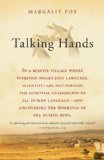Summary | Excerpt | Reviews | Beyond the Book | Readalikes | Genres & Themes | Author Bio

Critics' Opinion:
Readers' Opinion:
First Published:
Aug 2007, 368 pages
Paperback:
Aug 2008, 368 pages
 Book Reviewed by:
Book Reviewed by:
Lee Gooden
Buy This Book
In recent decades, the field of sign-language linguistics has established itself as one of the most yeasty, contentious and promising branches of cognitive science. As such, it is awash in competing scholarly opinions. In a book written for a general readership, it is impossible to give an exhaustive account of either the historical development of the discipline or its present state of affairs. What this book offers is an introduction to the linguistic study of sign language in the form of a representative cross section of the field and its preoccupations from its beginnings in the 1960s to the present day. It is a slice -- one of many possible slices -- of sign-language linguistics at the start of the twenty-first century, and is by no means intended to represent the field in toto. A bibliographic essay at the end of the book offers suggestions for further reading.
Some notes on usage: Anyone who writes about deafness quickly discovers that worlds of meaning, politics and identity hang on the capitalization of a single letter: the initial "d" of the word "deaf." In the United States, it is often customary to capitalize "Deaf" when referring to any self-identified member of the large cultural minority, united by common language and traditions, of people who cannot hear. (The word is lowercased when it refers strictly to the audiological condition.) After much deliberation, I have chosen to keep the word "deaf" lowercased throughout the pages of this book. My only motivation is typographic consistency, in particular as it applies to the discussions of Al-Sayyid, where capital-D concepts like "Deaf culture" and "Deaf power" are unknown by virtue of the fact that it is so utterly ordinary to be deaf there. I have, however, retained the original capitalization of the word in all quoted matter.
When one is writing about sign language, verbs of attribution also grow thorny. On a physiological level, no one "speaks" sign language, or ever "says" anything in sign. Sign languages have users. They have signers. But, technically, don't have speakers. A work of this length, however, begs for stylistic variety, and as a result, I sometimes use verbs of speech -- "speak," "say," "talk" -- along with their derivatives, to refer to the act of signed communication, as in the title of the book itself. These words are meant purely as loose, colloquial metaphors, to be understood much as "spoke" is in the title of the anthropologist Nora Groce's lovely book, Everyone Here Spoke Sign Language.
In a book about cognitive science, the terms "mind" and "brain" also pose a challenge to smooth usage. I have in general adopted the familiar "hardware-versus-software" analogy, using "brain" to refer to the physical structure within the cranial cavity and "mind" to denote the range of operations this physical structure can perform.
Talking Hands is organized into seventeen chapters. The odd-numbered chapters form the narrative of the linguists' visit to Al-Sayyid and their subsequent work deciphering its language. The even-numbered chapters chart the course of sign-language linguistics: Chapters 2 and 4 offer an introduction to the signed languages of the world, and to the aims of modern linguistics. Chapters 6 and 8 chronicle the birth of the scientific study of sign language, and examine the very special conditions that give rise to "signing villages" like Al-Sayyid. Chapters 10 and 12 describe the grammar of signed languages, focusing on the unusual means by which they build words and sentences. Chapters 14 and 16 explore the psychology of sign language -- memory for signs, "slips of the hand," and so on -- and what sign language has to tell us about the neurological workings of human language in the brain.
Finally, a note on sign-language transcription. Following the convention of sign-language linguistics, the English glosses for signs are printed in small capital letters: FATHER, ROOSTER, THINK. Where a single sign is glossed using two or more English words, they are linked with hyphens: YOUNGER-BROTHER, TAKE-CARE-OF, LEFT-SIDE. Compound signs are glossed with a ligature mark: THRILL^INFORM. Words spelled out by means of the manual alphabet are capitalized and hyphenated: W-A-T-E-R.
Text copyright © 2007 by Margalit Fox





The Flower Sisters
by Michelle Collins Anderson
From the new Fannie Flagg of the Ozarks, a richly-woven story of family, forgiveness, and reinvention.

The House on Biscayne Bay
by Chanel Cleeton
As death stalks a gothic mansion in Miami, the lives of two women intertwine as the past and present collide.

The Funeral Cryer by Wenyan Lu
Debut novelist Wenyan Lu brings us this witty yet profound story about one woman's midlife reawakening in contemporary rural China.
Your guide toexceptional books
BookBrowse seeks out and recommends the best in contemporary fiction and nonfiction—books that not only engage and entertain but also deepen our understanding of ourselves and the world around us.